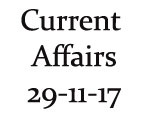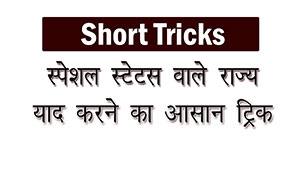-
Current Affairs 29th November 2017
Updated : 29-Nov-2017
Current Affairs 29th November 2017 - Important Points
- MoU signed between Airbnb and NSDC,THSC on - 28th November 2017
- New Bankruptcy Code in India approved on - 22nd November 2017
- India, UK to sign MoU to transform Urban Transport Sector on - 27th November 2017
- No guidelines on how to investigate cases of dowry harassment stated on - 29th November 2017
Current Affairs 29th November 2017 - Details
MoU signed between Airbnb and NSDC,THSC on - 28th November 2017
The National Skill Development Corporation and Tourism and Hospitality Sector Skill Council signed a tripartite Memorandum of Understanding with Airbnb in Delhi on 28th November 2017.
The MoU focuses to provide hospitality skills training to hospitality micro-entrepreneurs in India. Talking on the occasion, Union Minister for Skill Development and Entrepreneurship, Dharmendra Pradhan explained, “We believe that this partnership will help increase Skill India Mission by bringing in useful global practices for the training of small hospitality tycoons.”
The Minister further informed that the domestic tourism has huge potential in India and this partnership will advantage the ecosystem by creating opportunities for women and youngsters.Key Objectives
- The MoU is in line with the Union government’s endeavor to encourage entrepreneurship under the Government’s Skill India Program.
- Airbnb is the world’s leading community-driven hospitality organization, while NSDC is the implementation part of Ministry of Skill Development and Entrepreneurship.
- The Skill Development & Entrepreneurship Ministry, Airbnb, NSDC and THSC will be working with the partnership to jointly form an accredited skill development module for hospitality entrepreneurs contributing home stay facilities, special accommodations and local experiences.
- Furthermore, building on Airbnb’s promise to support Skill India Mission by creating 50,000 hospitality entrepreneurs in India, the MoU focuses to empower more peoples, including those living in rural and areas with poor services to join the ‘alternate accommodation’ sector and follow new livelihood opportunities by sharing their homes.
MoU terms
The 3 parties agreed to:- Establish occupation norms and competency matrices for job roles and design the courses for hospitality entrepreneurs contributing home stay facilities, other special accommodations and local experiences for travelers.
- Place the framework for long-term Council-Industry partnership.
- Strengthen the Skilled Labor Pool needed by Tourism and Hospitality industry.
New Bankruptcy Code in India approved on - 22nd November 2017
The Rajya Sabha on 22nd November 2017 approved the Insolvency and Bankruptcy Code 2016, an important reform that will ease the process of doing business in India. The Code’s emphasis on forming a framework for resolving insolvency has caught the imagination of the industry.
The bill was approved by the Lok Sabha last week. A majority of the parties in both Houses validated their support for this legislation after all the amendments proposed by a joint parliamentary committee were accepted by the government.
Now, the bill is with the President. Once the president approves the bill, this will give India a new bankruptcy law. And the time-bound settlement of insolvency, enable speedy turnaround of businesses and create a database of serial defaulters would be ensured in the Nation.
Bankruptcy- In terms of economics, being bankrupt is a lack of ability to repay loans to creditors.
- The new law explains that a bankrupt body is a debtor who has been announced as bankrupt by an adjudicating authority that has passed a bankruptcy order.
New Code - The new code is there to replace present bankruptcy laws and cover individuals, partnership organizations, companies, and limited liability associations. It will revise laws including the Companies Act to expand its legislation to deal with corporate insolvency. It will also be helpful for creditors to recover loans quickest.
- The bill has the planning that talks about the creation of a new class of insolvency professionals that will specialize in helping affected companies. It also has planning for creation of information tools that will compile all information about debtors to stop serial defaulters from misusing the system.
- The bill proposes to set up the Insolvency and Bankruptcy Board of India to act as a regulator of these tools and professionals.
- The new code proposes to utilize the present infrastructure of National Company Law tribunals and debt recovery tribunals to handle corporate insolvency and individual insolvency, respectively.
- The new law is expected to change India’s two debt recovery and enforcement laws and resolving India’s bad debt problem, which has hampered bank lending.
- At international level, the bankruptcy code has planning to address across border insolvency by bilateral agreements with other nations.
- To safeguard workers’ interests, the code has planning to protect that the money due to workers and employees from the provident fund, gratuity and the pension funds should not be included in the estate of the bankrupt organization or person.
- There are also planning that disqualify an announced bankrupt person from holding public office, thereby identifying that politicians and government representatives cannot hold any public office if announced bankrupt.
New Process to Bankruptcy - There are 5 steps which are considered while going further for the declaration of bankruptcy.
- At 1st- the NCLT or DRT is approached for starting the resolution process.
- 2nd- the creditors allocate an interim Insolvency Professional to take control of the debtor’s benefits and company’s operations, form the creditors’ committee and take financial information of the debtor from information sources.
- 3rd- the committee has to take actions pertaining to insolvency resolution by a 75% majority.
4th- once a resolution is cleared the committee has to think on the restructuring process that could either be a liquidation of the benefits of the company or a re-examined repayment plan for the organization. If no decision is finalized during the process, the debtor’s benefits will be liquidated to repay the debt. - 5th- the resolution plan will be passed to the tribunal for final acceptance, and implemented once accepted.
Impact - Presently, under the bankruptcy law, banks have lodged 18 cases that are at different stages, but resolution or liquidation plans have not been finalized in even single case. It is believed that the banks will go to the NCLT by next month in an effort to unlock the debt load piled on behalf of industries like Bhushan Power, Essar Steel Ltd, Bhushan Steel, Monnet Ispat and Energy and others.
- Earlier, RBI had identified the top 50 defaulters, some of who will likely include Jaypee Group, Bhushan Steel, Bhushan Power, Lanco, Videocon, Essar, ABG Shipyard, Punj Lloyd etc.
- Finance Minister Arun Jaitley also mentioned many times that the problem of bad loans wasn’t systemic, but restricted to 30-50 accounts.
Conclusion - In Indian law reforms, the insolvency and bankruptcy code can be treated as a very positive financial sector reform, mainly for the banks, as it will give creditors a legal way for recovering their due amounts in a time-bound manner. As per the experts, there are many laws dealing with insolvency in India which causes delays.
- Finally, its implementation into the basic level as the new code is portend on the creation of a complementary ecosystem containing insolvency professionals, information utilities, and a bankruptcy regulator.
India, UK to sign MoU to transform Urban Transport Sector on - 27th November 2017
India and United Kingdom will be signing a MoU in the urban transport area for cooperation in policy planning, technology movement and institutional organization.
The draft MoU for the similar was debated during the meeting of Union Transport Minister Nitin Gadkari and UK Secretary of State for Transport Chris Grayling in London on 27th November 2017.Key Objectives
- The draft MoU looks to facilitate cooperation in the transport area and enable the sharing of expertness and latest technology between the 2 countries in order to promote efficient mobility solutions.
- The MoU is also believed to usher in policy reforms that can transform the transport area through improved customer service/data analysis and better utilization of IT systems.
- It will also facilitate in promoting digital transactions and introduction of high capacity diesel/electric vehicles in India.
- Furthermore, it will establish the conditions on which such assistance can be provided.
- The decision to sign the agreement pursue Union Transport Minister Nitin Gadkari’s visit to London in May 2017, during which he had finalized bilateral cooperation agreements between Transport for London and Indian Ministry of Road Transport & Highways to cover a wide range of transport mobility answers and related activities in urban environment.
- During his present visit, Gadkari will also be directing a session of the International Maritime Organization.
- He also directed Indian business leaders in UK; encourage them to cooperate in the Namami Gange project of the Government.
No guidelines on how to investigate cases of dowry harassment stated on - 29th November 2017
The Supreme Court on 29th November 2017 ruled that it cannot design guidelines on how to investigate cases of dowry harassment as it is beyond the statutory plannings.
The Supreme Court bench including Chief Justice Dipak Misra, Justice AM Khanwilkar and Justice DY Chandrachud ruled that it will revisit the judgment given by a 2-judge bench which instructed the formation of committees to study the complaints of dowry harassment.
The 2-judge bench led by Justice AK Goel also laid down the guidelines to be followed in handling with the complaints of dowry harassment. The guidelines were formed on how police should be moving further in cases of dowry harassment under Section 498A of the Indian Penal Code.
However, the Supreme Court informed that the guidelines were not required for the implementation of statutory provision 498A handling dowry harassment cases.Previous ruling in dowry harassment case by two-judge SC bench
- In July 2017, the 2 judge Supreme Court bench including Justices A K Goel and UU Lalit ruled that the police cannot seize the accused without managing a preliminary inquiry under dowry harassment cases.
- The court held that arrests in dowry harassment cases, where the maximum punishment is up to 7 years in jail, cannot be made on an opinion that the accused may have performed an offence.
- The court's order came in the order of suspected misuse of the anti-dowry harassment law formed in 1983.














